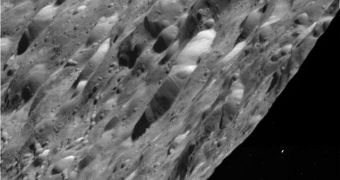Experts at the Jet Propulsion Laboratory (JPL) have released the latest images of the Saturnine moon Rhea, that the Cassini space probe collected during its January 11 flyby of the space object.
The NASA lab manages Cassini for the American space agency's Science Mission Directorate, in Washington DC. The spacecraft has been in orbit around the gas giant since July 1, 2004.
During this latest flyby, which took place at 4:53 am UTC, or 10:53 pm Pacific Time on Monday, January 10, Cassini descended to as little as 69 kilometers (43 miles) above the surface of Rhea.
JPL experts hope that the space probe's instruments were able to collect new data, that could give them more insight into Saturn's extensive ring system. The reason why Rhea was selected for this investigation is that it has virtually no atmosphere.
This “allows Cassini's cosmic dust analyzer and radio and plasma wave instrument to detect the dusty debris that flies off the surface from tiny meteoroid bombardments,” experts at the Lab say.
The new raw images of the icy moon's surface are very detailed due to the close proximity of the spacecraft's instruments. Shadowy craters are visible at low Sun angle, as the mission carried out the new observations during a fortuitous arrangement of Saturn, Rhea and the star.
“Images obtained by Cassini's imaging science subsystem show an old, inert surface saturated with craters, just like the oldest parts of Earth's Moon,” the press release accompanying the images says.
“But there appear to be some straight faults that were formed early in Rhea's history, which never developed the full-blown activity seen on another of Saturn's moons, Enceladus,” it adds.
Enceladus is believed to contribute to refreshing Saturn's E ring, with water-ice and organic molecules it spews out from cracks at its south pole. Cassini has imaged the tiger stripe-like structures extensively.
“The flyby of Rhea also presented scientists with their best available chance to study how often tiny meteoroids bombard the moon's surface,” the JPL science team says.
“Scientists are now sifting through data collected on the close flyby by the cosmic dust analyzer and the radio and plasma wave science instrument,” it adds.
“They will use the data to deduce how often objects outside the Saturn system contaminate Saturn's rings, and to improve estimates of how old the rings are,” the statement concludes.

 14 DAY TRIAL //
14 DAY TRIAL //